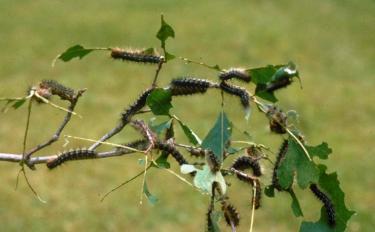When Gypsy Moths Attack
When gypsy moths move in, they can completely defoliate the trees. Since they're not native to North America, they have few natural enemies to keep them in check.
What Do They Do to My Trees?
Gypsy moths kill host trees indirectly. The caterpillars feast on the leaves, which stresses the trees and paves the way for other attackers, such as the two-lined chestnut borer and shoestring root rot.
Gypsy moths attack many species of trees. Hemlock, pine, and spruce may die after one year of defoliation by the gypsy moth. Deciduous trees can usually survive one year of attack, but two or more years of defoliation may be deadly.
Egg masses are light tan and the eggs inside are black and pelletlike. The caterpillar (larva) is hairy. A mature caterpillar is about two inches long with a yellow and black head with pairs of red and blue spots down its back. Adult male moths are dark buff and fly readily during the day. Females are white with black wavy markings. They do not fly, although their wingspan can reach up to two inches.
Females lay egg masses in the summer. The eggs overwinter on trees, stones, vehicles, and other surfaces, then hatch in spring. Young caterpillars feed on foliage and mature in early summer. Adults start emerging in mid-summer to mate and lay the new generation of eggs.
If you think gypsy moths have reached your woods, there are steps you can take to control the infestation.
How can I get more tips?
It’s simple! Enter your email below.

